Automatic Identification of Sound Source Position Coordinates Using a Sound Metric System of Sensors Linked with an Internet Connection
Abstract
1. Introduction
2. Materials and Methods
- Electronic stopwatch. Their conditional accuracy is up to 0.001 s.
- Thermometer. An ordinary electronic thermometer has a measurement accuracy of up to 0.1 °C.
- Hygrometer. Digital hygrometers have a measurement accuracy of up to 1%.
- Barometer. Digital barometer with an accuracy of 10 Pa.
- A sound and noise meter (microphone) with a frequency range of 31–8000 Hz. By connecting this device to our sensor, we will obtain a sensor-receiver. After registering a sound wave, the sensor receiver will send a message to the server.
- X—shot point, target point, position of which must be found.
- A, B, C, D—sound receivers that can measure air temperature and humidity and have access to the Internet.
- Server—a program that will determine the position of the target point, which can be connected via the Internet.
- Command post—a place where there is the computer on which the program runs (it can be weapon given automatically) that subscribes to the program that is hosted on the server and uses its data.
- The target point creates sound.
- Sound propagates from the target point to the sensors.
- The sensor receives sound and sends messages to the server via the Internet.The message contains:- Sensor ID.- Sensor geolocation.- Air temperature where the sensor is located.- Humidity of the air where the sensor is located.
- The server program receives the message.- The program determines the connection delay.- The program calculates at what point in time the sensor has received the sound and sent a message (taking into consideration a delay)- The program also determines the sound speed using the data about temperature and humidity received by the message from the sensor.
- The program waits for 4 such messages, as mentioned above.
- The program receives the fourth message.- The program determines t1, t2, and t3 according to the absolute times defined in paragraph 4.- The program determines average speeds v1, v2 and v3 according to time, according to speeds defined in paragraph 4.- An array of sensor coordinates from which the message was received is transmitted.
- The program determines the position (x, y) of the target point according to the data specified in paragraph 6.
2.1. Geometric Model of Finding the Coordinates of the Sound Source
2.2. Calculation of the Source Position Coordinates of the Acoustic Wave
3. Results
3.1. Structure of Software Implementation of the System for Automatic Identification of Sound Source Position Coordinates
3.2. Calculation of Relative Error Identification of x and y Coordinates of Sound Sources Depending on Temperature, Humidity and Wind Direction and Its Speed
- We logarithmize the expression (9).
- We take the differential from the natural logarithm and group the terms that contain the same differential
- We will replace all minuses with pluses
4. Discussion
5. Conclusions
- A new algorithm for determining the coordinates of the location of sound sources has been developed. The algorithm takes into account the change in the phase speed of the sound wave when the temperature, air humidity, wind direction and wind speed change and does not lead to the appearance of a systematic error in the measurement of the direction angle to the target.
- A system for automatically determining the coordinates of the position of the sound source, containing the server, client and sensor-receiver subroutines, has been implemented in software.
- It was calculated that at a temperature of and relative humidity , with an increase in the distance between the sensor-receivers from 20 m to 1000 m, located at the vertices of the square, the relative error in determining the coordinates of the sound source location decreases from 7.37% to 0.15%.
- The analysis of the influence of temperature and relative air humidity showed that with an increase in temperature from to and an increase in relative air humidity from 10% to 90% with a fixed location of the sensor-receivers, the relative error in determining the position of the coordinates of the sound source increases from 0.57% to 0.63%.
- It was recognized that the relative error of determining the coordinates of the position of the sound sources is minimal if the sensor-receivers are placed at the vertices of a flat figure with 4 axes of symmetry of the second order.
Author Contributions
Funding
Data Availability Statement
Acknowledgments
Conflicts of Interest
References
- Chung, M.-A.; Chou, H.-C.; Lin, C.-W. Sound Localization Based on Acoustic Source Using Multiple Microphone Array in an Indoor Environment. Electronics 2022, 11, 890. [Google Scholar] [CrossRef]
- Yang, X.; Xing, H.; Ji, X. Sound Source Omnidirectional Positioning Calibration Method Based on Microphone Observation Angle. Complexity 2018, 2018, 2317853. [Google Scholar] [CrossRef]
- Gala, D.; Lindsay, N.; Sun, L. Realtime Active Sound Source Localization for Unmanned Ground Robots Using a Self-Rotational Bi-Microphone Array. J. Intell. Robot. Syst. 2019, 95, 935–954. [Google Scholar] [CrossRef]
- Astaras, C.; Linder, J.; Wrege, P.; Orume, R.; Macdonald, D. Passive acoustic monitoring as a law enforcement tool for Afrotropical rainforests. Front. Ecol. Environ. 2017, 15, 233–234. [Google Scholar] [CrossRef]
- Zhang, T.; Wang, Z.; Li, Y.; Tong, J. A Passive Acoustic Positioning Algorithm Based on Virtual Long Baseline Matrix Window. J. Navig. 2019, 72, 193–206. [Google Scholar] [CrossRef]
- Liaquat, M.U.; Munawar, H.S.; Rahman, A.; Qadir, Z.; Kouzani, A.Z.; Mahmud, M.A.P. Localization of Sound Sources: A Systematic Review. Energies 2021, 14, 3910. [Google Scholar] [CrossRef]
- Tortosa, D.; Herrero-Durá, I.; Otero, J.E. Acoustic Positioning System for 3D Localization of Sound Sources Based on the Time of Arrival of a Signal for a Low-Cost System. Eng. Proc. 2021, 10, 15. [Google Scholar]
- Wu, P.; Su, S.; Zuo, Z.; Guo, X.; Sun, B.; Wen, X. Time Difference of Arrival (TDoA) Localization Combining Weighted Least Squares and Firefly Algorithm. Sensors 2019, 19, 2554. [Google Scholar] [CrossRef]
- Rabenstein, R.; Annibale, P. Acoustic Source Localization under Variable Speed of Sound Conditions. Wirel. Commun. Mob. Comput. 2017, 2017, 9524943. [Google Scholar] [CrossRef]
- Sand, S.; Dammann, A.; Mensing, C. Position estimation. In Positioning in Wireless Communications Systems; Wiley: Hoboken, NJ, USA, 2014; pp. 69–93. [Google Scholar]
- Crocco, M.; Cristani, M.; Trucco, A.; Murino, V. Audio Surveillance: A Systematic Review. ACM Comput. Surv. 2016, 48, 1–46. [Google Scholar] [CrossRef]
- Cobos, M.; Antonacci, F.; Alexandridis, A.; Mouchtaris, A.; Lee, B. A Survey of Sound Source Localization Methods in Wireless Acoustic Sensor Networks. Wirel. Commun. Mob. Comput. 2017, 2017, 3956282. [Google Scholar] [CrossRef]
- Li, Z.; Yiu, K.F.C.; Nordholm, S. On the Indoor Beamformer Design with Reverberation. IEEE/ACM Trans. Audio Speech Lang. Process. 2014, 22, 1225–1235. [Google Scholar] [CrossRef]
- Kotus, J.; Szwoch, G. Localization of sound sources with dual acoustic vector sensor. In Proceedings of the 2019 Signal Processing: Algorithms, Architectures, Arrangements, and Applications (SPA), Poznan, Poland, 18–20 September 2019; pp. 44–49. [Google Scholar]
- Kim, K.; Wang, S.; Ryu, H.; Lee, S.Q. Acoustic-Based Position Estimation of an Object and a Person Using Active Localization and Sound Field Analysis. Appl. Sci. 2020, 10, 9090. [Google Scholar] [CrossRef]
- Xing, H.; Yang, X. Sound Source Localization Fusion Algorithm and Performance Analysis of a Three-Plane Five-Element Microphone Array. Appl. Sci. 2019, 9, 2417. [Google Scholar] [CrossRef]
- Alameda-Pineda, X.; Horaud, R. A Geometric Approach to Sound Source Localization from Time-Delay Estimates. IEEE/ACM Trans. Audio Speech Lang. Process. 2014, 22, 1082–1095. [Google Scholar] [CrossRef]
- Boukerche, A.; Oliveira, H.A.B.F.; Nakamura, E.F.; Loureiro, A. Localization systems for wireless sensor networks. IEEE Wirel. Commun. 2007, 14, 6–12. [Google Scholar] [CrossRef]
- Zekavat, S.R.; Buehrer, R.M.; Durgin, G.D.; Lovisolo, L.; Wang, Z.; Goh, S.T.; Ghasemi, A. An Overview on Position Location: Past, Present, Future. Int. J. Wirel. Inf. Netw. 2021, 28, 45–76. [Google Scholar] [CrossRef]
- Transforming Our World: The 2030 Agenda for Sustainable Development|Department of Economic and Social Affairs. Available online: https://sdgs.un.org/2030agend (accessed on 25 July 2022).
- Aguilar, J.R. Gunshot location systems the transfer of the sniper detection technology from military to civilian applications. In Proceedings of the 47th International Carnahan Conference on Security Technology (ICCST), Medellin, Colombia, 8–11 October 2013; pp. 1–6. [Google Scholar]
- Valenzise, G.; Gerosa, L.; Tagliasacchi, M.; Antonacci, F.; Sarti, A. Scream and gunshot detection and localization for audio-surveillance systems. In Proceedings of the IEEE Conference on Advanced Video and Signal Based Surveillance, London, UK, 5–7 September 2017; pp. 21–26. [Google Scholar]
- Rawtani, D.; Gupta, G.; Khatri, N.; Rao, P.K.; Mustansar, C. Environmental damages due to war in Ukraine: A perspective. Sci. Total Environ. 2022, 850, 157932. [Google Scholar] [CrossRef]
- Dijkstra, H.; Cavelty, M.D.; Jenne, N.; Reykers, Y. War in Ukraine. Contemp. Secur. Policy 2022, 43, 464–465. [Google Scholar] [CrossRef]
- Baluta, S.; Andrei, G. Determining the Coordinates of a Hostile Gunfire by Using the Sound Ranging Method. In Proceedings of the International Conference of Scientific Paper AFASES 2012, Brasov, Romania, 24–26 May 2012; pp. 637–640. [Google Scholar]
- Kochan, R.; Trembach, B.; Kochan, O. Methodical Error of Targets Bearing by Sound Artillery Intelligence System. Meas. Equip. Metrol. 2019, 80, 10–14. [Google Scholar]
- Trembach, B.; Kochan, R. Analysis of the error of the measurement of direction angle to a target using the distributed system of acoustic artillery reconnaissance. Meas. Equip. Metrol. 2016, 77, 177–182. [Google Scholar]
- Ginn, K.B.; Haddad, K. Noise source identification techniques: Simple to advanced applications. In Proceedings of the Acoustics, Nantes, France, 23–27 April 2012; pp. 1782–1786. [Google Scholar]
- Kapka, S.; Lewandowski, M. Sound Source Detection, Localization And Classification Using Consecutive Ensemble Of CRNN Models. In Proceedings of the Detection and Classification of Acoustic Scenes and Events Workshop (DCASE2019), New York, NY, USA, 25–26 October 2019; pp. 119–123. [Google Scholar]
- Pourmohammad, A.; Ahadi, S.M. N-dimensional N-microphone sound source localization. EURASIP J. Audio Speech Music Process. 2013, 2013, 27. [Google Scholar]
- Calculation of the Minimum Relative Error of Determining the Coordinates of the Position of the Sound Source in a Graphic Calculator Desmos. Available online: https://www.desmos.com/calculator/3ycakilsjr (accessed on 25 July 2022).
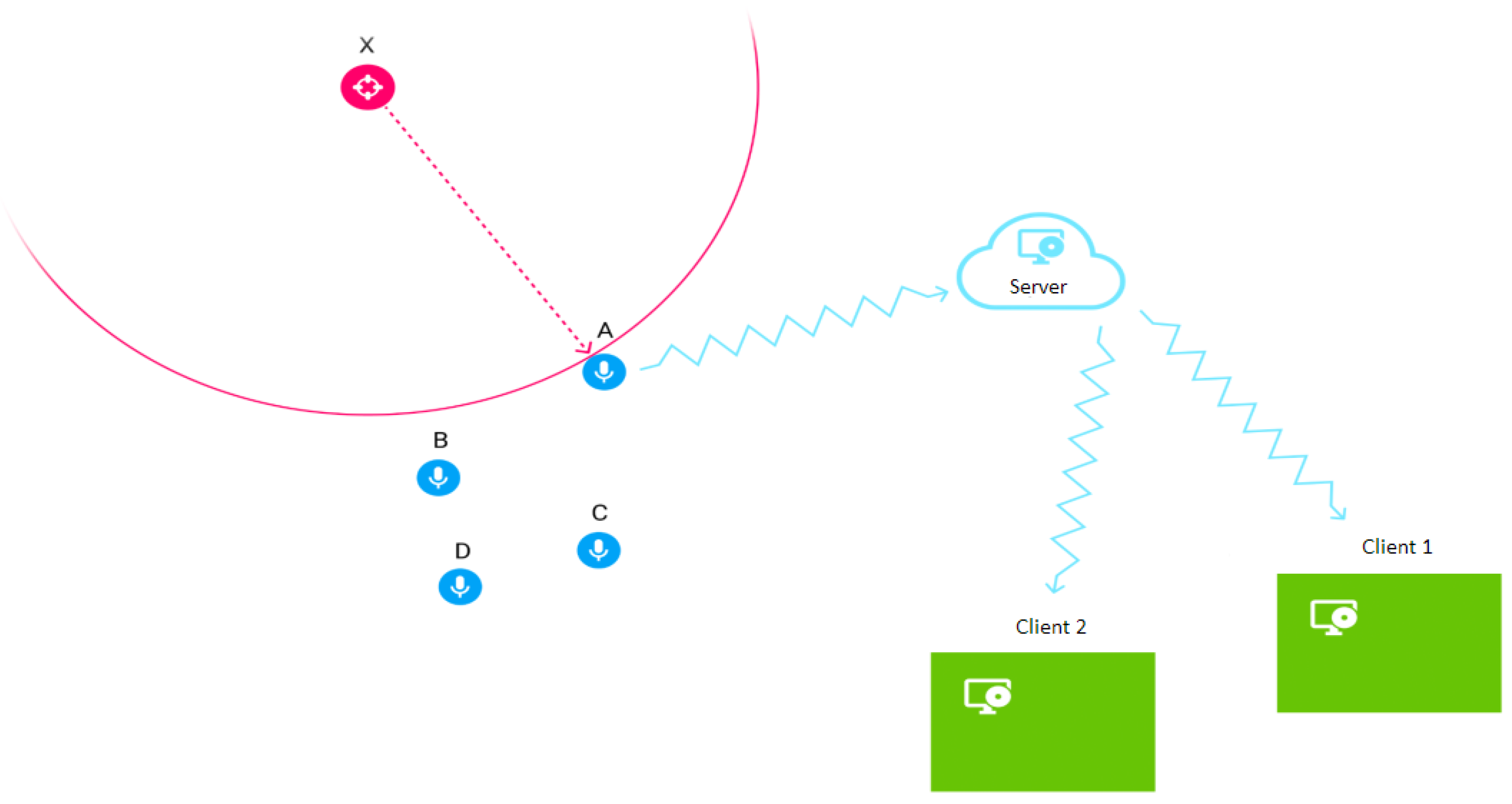
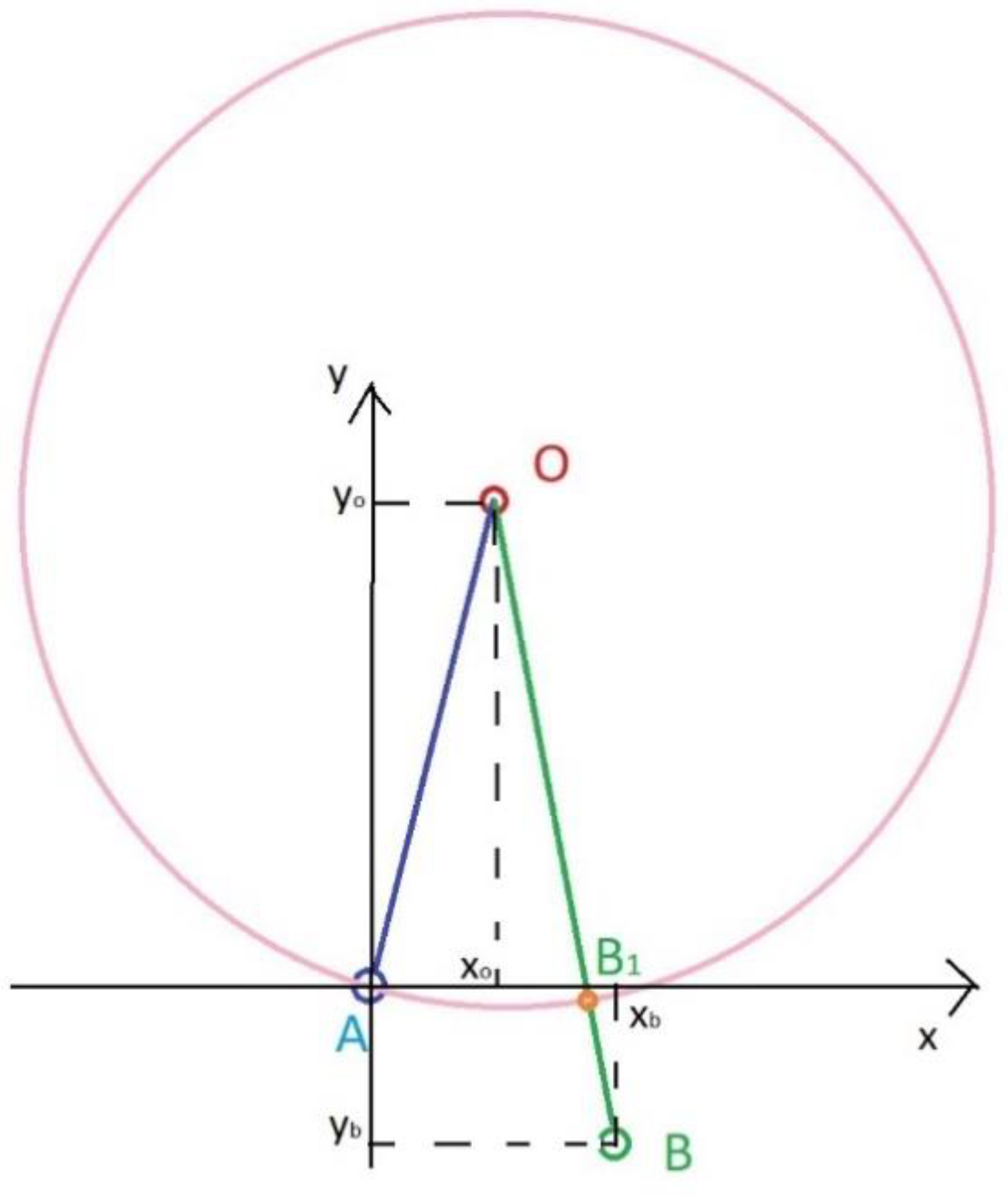
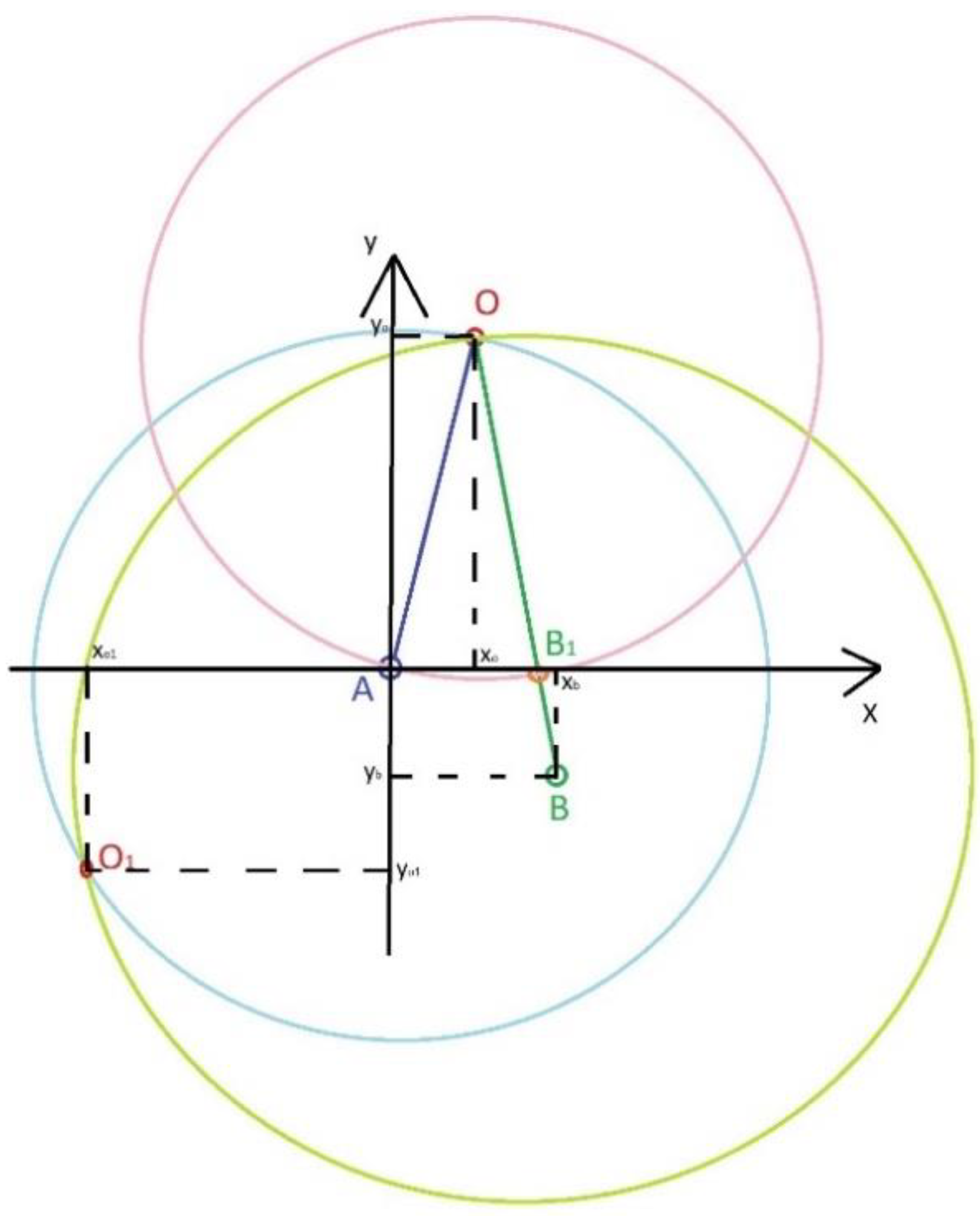

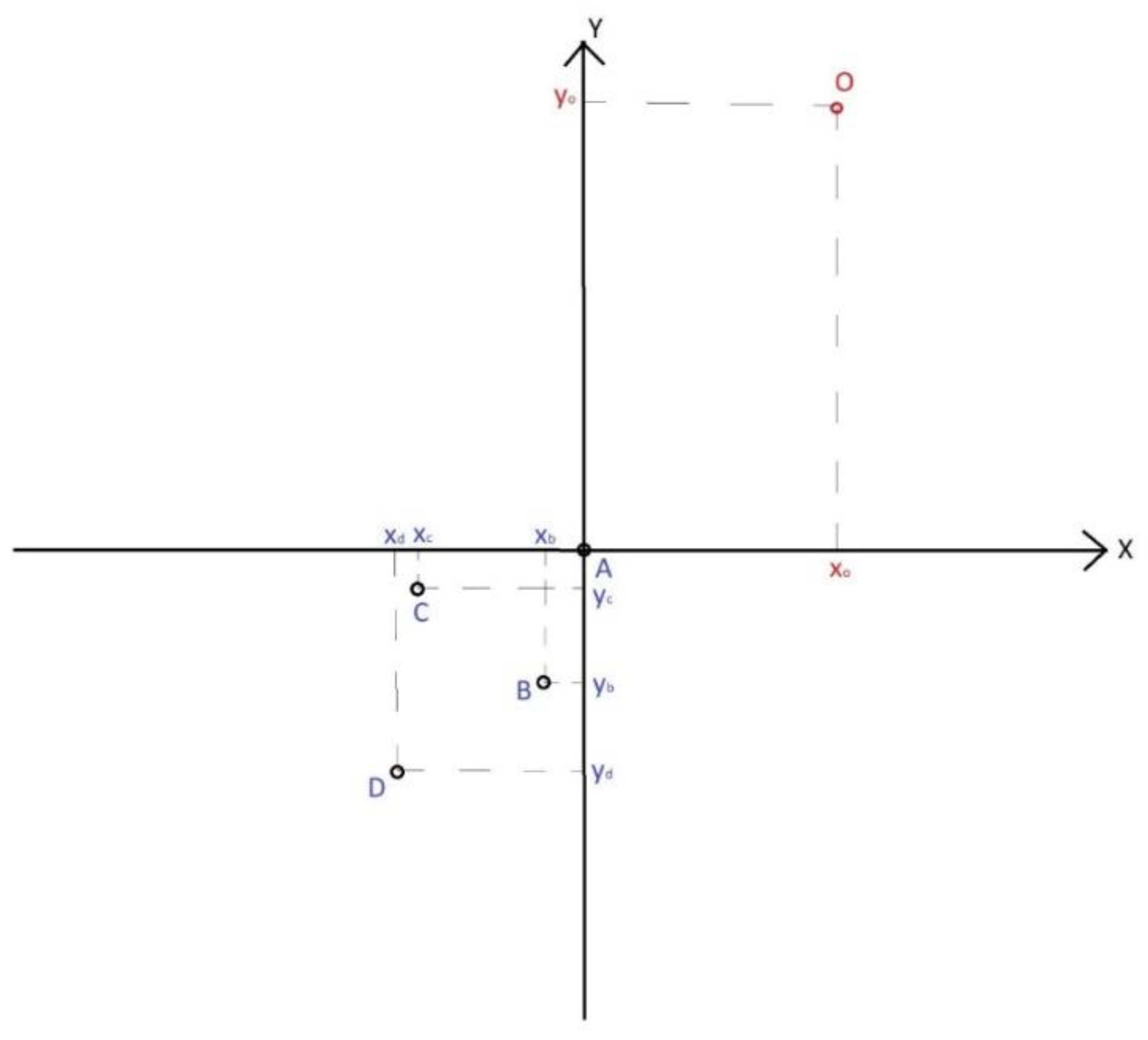
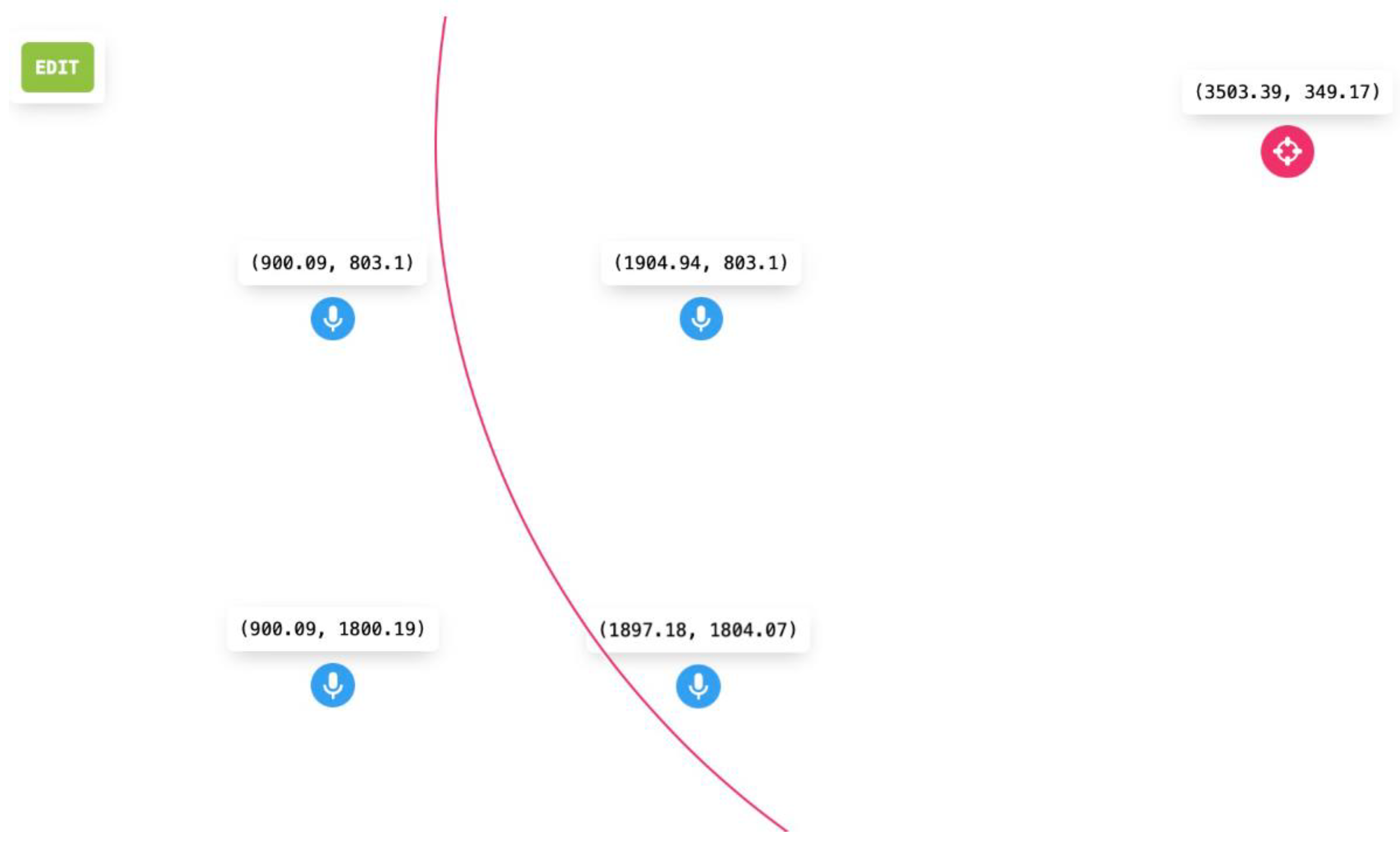
| “Dry” Thermometer Temperature, C | Difference between Values of Temperatures of “Dry” and “Wet” Thermometers | ||||||||||
|---|---|---|---|---|---|---|---|---|---|---|---|
| 0 | 1 | 2 | 3 | 4 | 5 | 6 | 7 | 8 | 9 | 10 | |
| Relative Air Humidity, % | |||||||||||
| 12 | 100 | 89 | 78 | 68 | 57 | 48 | 38 | 29 | 20 | 11 | - |
| 13 | 100 | 89 | 79 | 69 | 59 | 49 | 40 | 31 | 23 | 14 | 6 |
| 14 | 100 | 89 | 79 | 70 | 60 | 51 | 42 | 34 | 25 | 17 | 9 |
| 15 | 100 | 90 | 80 | 71 | 61 | 52 | 44 | 36 | 27 | 20 | 12 |
| 16 | 100 | 90 | 81 | 71 | 62 | 54 | 46 | 37 | 30 | 22 | 15 |
| 17 | 100 | 90 | 81 | 72 | 64 | 55 | 47 | 39 | 32 | 24 | 17 |
| 18 | 100 | 91 | 82 | 73 | 65 | 56 | 49 | 41 | 34 | 27 | 20 |
| 19 | 100 | 91 | 82 | 74 | 65 | 58 | 50 | 43 | 35 | 29 | 22 |
| 20 | 100 | 91 | 83 | 74 | 66 | 59 | 51 | 44 | 37 | 30 | 24 |
| 21 | 100 | 91 | 83 | 75 | 67 | 60 | 52 | 46 | 39 | 32 | 26 |
| 22 | 100 | 92 | 83 | 76 | 68 | 61 | 54 | 47 | 40 | 34 | 28 |
| 23 | 100 | 92 | 84 | 76 | 69 | 61 | 55 | 48 | 42 | 36 | 30 |
| 24 | 100 | 92 | 84 | 77 | 69 | 62 | 56 | 49 | 43 | 37 | 31 |
| 25 | 100 | 92 | 84 | 77 | 70 | 63 | 57 | 50 | 44 | 38 | 33 |
| 1 | ||
| 2 | ||
| 3 | ||
| 4 | ||
| 5 | ||
| 6 | ||
| 7 | ||
| 8 | ||
| 9 | ||
| 10 |
| № | The Distance between the Sensor-Receivers (Side of the Square), m | The Relative Error of Determining the Coordinate of the Position of the Sound Source, % |
|---|---|---|
| 1 | 20 | 7.37 |
| 2 | 50 | 2.88 |
| 3 | 70 | 2.02 |
| 4 | 100 | 1.37 |
| 5 | 200 | 0.61 |
| 6 | 300 | 0.35 |
| 7 | 500 | 0.18 |
| 8 | 1000 | 0.15 |
| 9 | 2000 | 0.18 |
| 10 | 5000 | 0.25 |
| № | Air Temperature, ℃ | The Relative Error of Determining the Coordinate of the Position of the Sound Source, % |
|---|---|---|
| 1 | −10 | 0.57 |
| 2 | −5 | 0.58 |
| 3 | 0 | 0.58 |
| 4 | 5 | 0.59 |
| 5 | 10 | 0.60 |
| 6 | 15 | 0.60 |
| 7 | 20 | 0.61 |
| 8 | 25 | 0.62 |
| 9 | 30 | 0.62 |
| 10 | 35 | 0.63 |
| № | Relative Humidity, % | The Relative Error of Determining the Coordinate of the Position of the Sound Source, % |
|---|---|---|
| 1 | 10 | 0.60 |
| 2 | 20 | 0.61 |
| 3 | 30 | 0.61 |
| 4 | 40 | 0.61 |
| 5 | 50 | 0.61 |
| 6 | 60 | 0.61 |
| 7 | 70 | 0.61 |
| 8 | 80 | 0.61 |
| 9 | 90 | 0.61 |
| № | Distance between the Sensors (the Side of the Square), m | Relative Error of the Coordinate Finding, % |
|---|---|---|
| 1 | 20 | 7.37 |
| 2 | 50 | 2.88 |
| 3 | 70 | 2.02 |
| 4 | 100 | 1.37 |
| 5 | 200 | 0.61 |
| 6 | 300 | 0.35 |
| 7 | 500 | 0.18 |
| 8 | 1000 | 0.15 |
| 9 | 2000 | 0.18 |
| 10 | 5000 | 0.25 |
Publisher’s Note: MDPI stays neutral with regard to jurisdictional claims in published maps and institutional affiliations. |
© 2022 by the authors. Licensee MDPI, Basel, Switzerland. This article is an open access article distributed under the terms and conditions of the Creative Commons Attribution (CC BY) license (https://creativecommons.org/licenses/by/4.0/).
Share and Cite
Kowalska-Styczeń, A.; Peleshchak, R.; Lytvyn, V.; Peleshchak, I.; Dyriv, A.; Danylyk, V. Automatic Identification of Sound Source Position Coordinates Using a Sound Metric System of Sensors Linked with an Internet Connection. Symmetry 2022, 14, 2338. https://doi.org/10.3390/sym14112338
Kowalska-Styczeń A, Peleshchak R, Lytvyn V, Peleshchak I, Dyriv A, Danylyk V. Automatic Identification of Sound Source Position Coordinates Using a Sound Metric System of Sensors Linked with an Internet Connection. Symmetry. 2022; 14(11):2338. https://doi.org/10.3390/sym14112338
Chicago/Turabian StyleKowalska-Styczeń, Agnieszka, Roman Peleshchak, Vasyl Lytvyn, Ivan Peleshchak, Andrii Dyriv, and Vitalii Danylyk. 2022. "Automatic Identification of Sound Source Position Coordinates Using a Sound Metric System of Sensors Linked with an Internet Connection" Symmetry 14, no. 11: 2338. https://doi.org/10.3390/sym14112338
APA StyleKowalska-Styczeń, A., Peleshchak, R., Lytvyn, V., Peleshchak, I., Dyriv, A., & Danylyk, V. (2022). Automatic Identification of Sound Source Position Coordinates Using a Sound Metric System of Sensors Linked with an Internet Connection. Symmetry, 14(11), 2338. https://doi.org/10.3390/sym14112338






